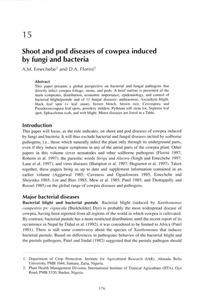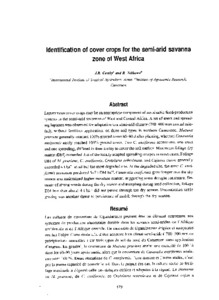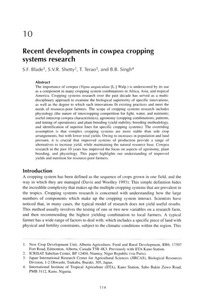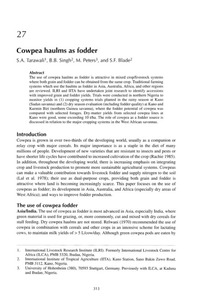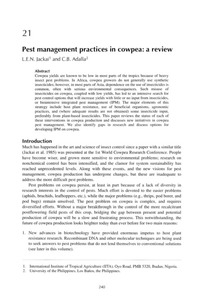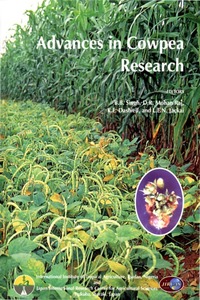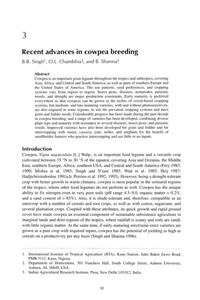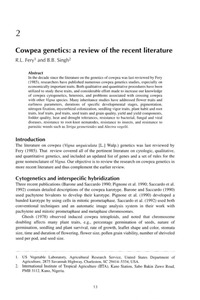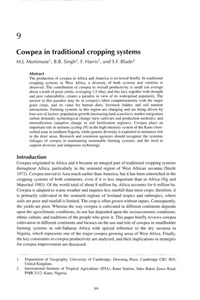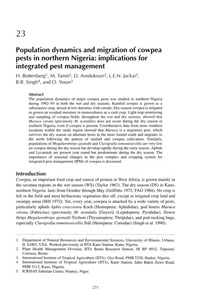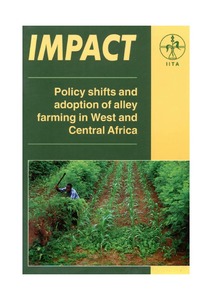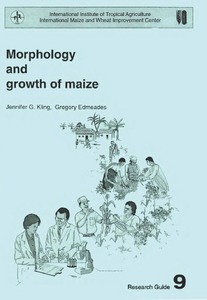Welcome to the International Institute of Tropical Agriculture Research Repository
Books and Book Chapters: Recent submissions
Now showing items 701-720 of 983
-
Shoot and pod diseases of cowpea induced by fungi and bacteria
(1997)This paper presents a global perspective on bacterial and fungal pathogens that directly infect cowpea foliage, stems, and pods. A brief outline is presented of the main symptoms, distribution, economic importance, epidemiology, and control of bacterial blight/pustule and of 11 fungal diseases: anthracnose, Ascochyta blight, black leaf spot (= leaf smut), brown blotch, brown rust. Cercospora and Pseudocercospora leaf spols. powdery mildew. Pythium soft stem rot. Septoria leaf spot. Sphaceloma scab, ... -
Identification of cover crops for the semi-arid savanna zone of West Africa
Leguminous cover crops may be an appropriate component of sustainable food-production systems in the semi-arid savannas of West and Central Africa- A set of erect and spreading legumes was observed for adaptation D to a semi-arid climate (700-900 mm annual rain-fall), without fertilizer application, on three soil types in northern Cameroon. Mucuna pruriens generally reached l00% ground cover 60-90 d after planting, whereas Canavalia ensiformis rarely reached 100% ground cover, Two C. ensiformis ... -
Recent developments in cowpea cropping systems research
(1997)The imponance of cowpea (Vigna unguiculata [L.] Walp.) is underscored by its use as a component in many cropping system combinations in Africa, Asia, and tropical America. Cropping systems research over the past decade has served as a multidisciplinary approach to examine the biological superiority of specific innovations, as well as the degree to which such innovations fit existing practices and meet the needs of resource-poor farmers. The scope of cropping systems research includes physiology ... -
The feasibility of classical biological control of two major cowpea insect pests
(1997)Biological control, as a key component of biointensive IPM in cowpea, is evaluated for its practical feasibility. The case study of one of the major insect pests, the bean flower thrips Megalumthrips sjosredti (Trybom) (Thysanoptera, Thripidae), is used to indicate the most important criteria for this evaluation: the nature of the pest and the release habitat, the availability and effectiveness of biological control agents, and the current status of biocontrol against the target pest. Although ... -
Origin, taxonomy and morphology of Vigna unguiculata (L.) Walp
(1997)Cowpea (V. unguiculata) represents the main food legume in tropical Africa. Germplasm collecting missions launched over the past 10 years have provided genebanks with a wide array of variability within the cultivated and wild taxa of the species. Based on detailed studies on morphological diversity of live materials along with extensive survey of materials in major Vigna herbaria and ecogeographical information, a new intra specific classification recognizing 13 varieties of wild cowpea has been ... -
Oppotunities for biotechnology in cowpea
(1997)Several applications of biotechnology have been successfully used recently in cowpea. A molecular map of cowpea has been constructed using RFLP markers, and this has already facilitated the localization of certain quantitative trait loci; gene chromosome localization using in situ hybridization is in progress. Appropriate bioassays have been developed that have facilitated the identification of candidate genes for insect pest resistance in cowpea, including Bacillus rhttrins>ensis protoxin genes, ... -
Flavonoid HPLC fingerprints of wild Vigna species
(1997)Thirty-two wild species and varieties of Vigna of different origin were screened for their flavotioid content. The compounds detected were utilizcd to assess both interand intraspecific relationships. Flavonoid HPLC fingerprints support evidence for the existence of different flavonoid chemotypes. which may reflect differences in geographic origin. As far as interspecific relationships ;irc concerned, species belonging lo sections Vigna, Plectotropis, and Ceratotropis do not show flavonoid glycosides ... -
Isozyme markers and taxonomic relationships among Vigna species
(1997)Isozyme markers are commonly used to study populations, taxonomy, and the genetics of crop species. In the genus Vigna. these markers have been investigated mainly to assess genetic diversity in the V. unguiculata complex. The aim of this study was to extend isozyme analysis to other sections of the genus Vigna. in order to evaluate their taxonomic relationships. Nine species of the sections Cariciitg,Vigna, and Plectotropis were tested. Interest in the selected species is high since they carry ... -
Cowpea haulms as fodder
(1997)The use of cowpea haulms as fodder is attractive in mixed crop/livestock systems where both grain and fodder can be obtained from the same crop. Traditional farming systems which use the haulms as fodder in Asia, Australia, Africa, and other regions are reviewed. ILRI and I1TA have undertaken joint research to identify accessions with improved grain and fodder yields. Trials were conducted in northern Nigeria to monitor yields in (1) cropping systems trials planted in the rainy season at Kano ... -
Wide crossing in African Vigna species
(1997)The genus Vigna comprises seven subgenera and sixteen sections. Cowpea, Vigna tingnicnlatti (L.) Walp.. is an important grain legume crop in sub-Saharan Africa and belongs to the subgenus Vigna. section Ctitiang. Morphologically, cowpea genotypes appear very variable. However, a high level of genome homology exists among the varieties and this, probably, is because genomes of cowpca's wild relatives have not been exploited while these varieties were being developed. Cowpea varieties are susceptible ... -
Pest management practices in cowpea: a review
(1997)Cowpea yields are known to be low in most parts of the tropics because of heavy insect pest problems. In Africa, cowpea growers do not generally use synthetic insecticides; however, in most parts of Asia, dependence on the use of insecticides is common, often with serious environmental consequences. Such misuse of insecticides on cowpen, coupled with low yields, has led to an intensive search for pest control options that will increase yields with l i t t l e or no input from insecticides, or ... -
Advances in cowpea research
(1997) -
Recent advances in cowpea breeding
(1997)Cowpea is an important grain legume throughout the tropics and subtropics, covering Asia, Africa, and Central and South America, as well as parts of southern Europe and the United States of America. The use patterns, seed preferences, and cropping systems vary from region to region. Insect pests, diseases, nematodes, parasitic weeds, and drought are major production constraints. Early maturity is preferred everywhere so that cowpeas can be grown in the niches of cereal-based cropping systems, but ... -
Molecular markers and genome mapping in cowpea
(1997)Molecular markers such as RFLPs exist in almost limitless number in all organisms, and these could be very useful in monitoring the loci of genes that control important traits, as well as in studying genome evolution and structure. In cowpea, a genome map based mainly on RFLP markers has been developed. This map presently has 92 markers and spans 717cm of the genome. Using this map, quantitative trait loci (QTLs) for seed weight, pod length, and aphid resistance have been identified. Phylogenetic ... -
Cowpea genetics: a review of the recent literature
(1997)In the decade since the literature on the genetics of cowpea was last reviewed by Fery (1985). Researchers have published numerous cowpea genetics studies, especially on economically important traits. Both qualitative and quantitative procedures have been utilized to study these traits, and considerable effort made to increase our knowledge of cowpea cytogenetics, heterosis, and problems associated with crossing cowpea with other Vigiia species. Many inheritance studies have addressed flower traits ... -
Cowpea in traditional cropping systems
(1997)The production of cowpea in Africa and America is reviewed briefly. In traditional cropping systems in West Africa, a diversity of both systems and varieties is observed. The contribution of cowpea to overall productivity is small (on average about a tenth of grain yields, averaging 1.5 l/ha), and this fact, together with drought and pest vulnerability, creates a paradox in view of its widespread popularity. The answer to this paradox may lie in cowpea's labor complementarity with the major grain ... -
Population dynamics and migration of cowpea pests in northern Nigeria: implications for integrated pest management
(1997)The population dynamics of major cowpea pests was studied in northern Nigeria during 1992-95 in both the wet and dry seasons. Rainfall cowpea is grown as a subsistence crop, mixed at low densities with cereals. Dry-season cowpea is irrigated or grown on residual moisture in monocultures as a cash crop. Light-trap monitoring and sampling of cowpea fields, throughout the wet and dry seasons, showed that Manica \iirata (previously M. testulalis) does not occur during the dry season in northern Nigeria, ... -
Policy shifts and adoption of alley farming in West and Central Africa
(1999)Alley farming is an improved fallow technology developed at the International Institute of Tropical Agriculture (IITA) as a sustainable alternative to slash-and-burn systems practiced by farmers in sub-Saharan Africa. Constraints to the use of the technology have been examined, but studies are limited which quantitatively assess determinants of farmers' adoption, and the financial profitability of alley farming under alternative policies. The objectives of this paper are to (i) determine the levels ... -
Morphology and growth of maize: IITA research guide, No. 9
(1997)Maize is one of the important food crops worldwide. It has a remarkable productive potential. However, considerable variation exists among varieties in morphology and growth habit. Management of a maize crop with respect to interaction of genotype and environment requires specific knowledge of maize growth and development.

